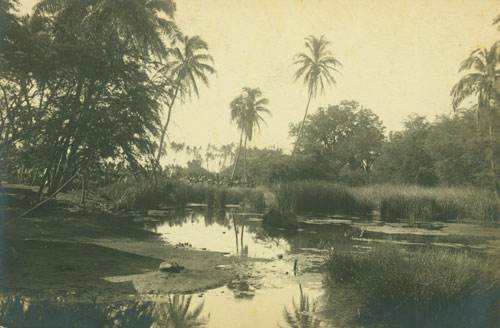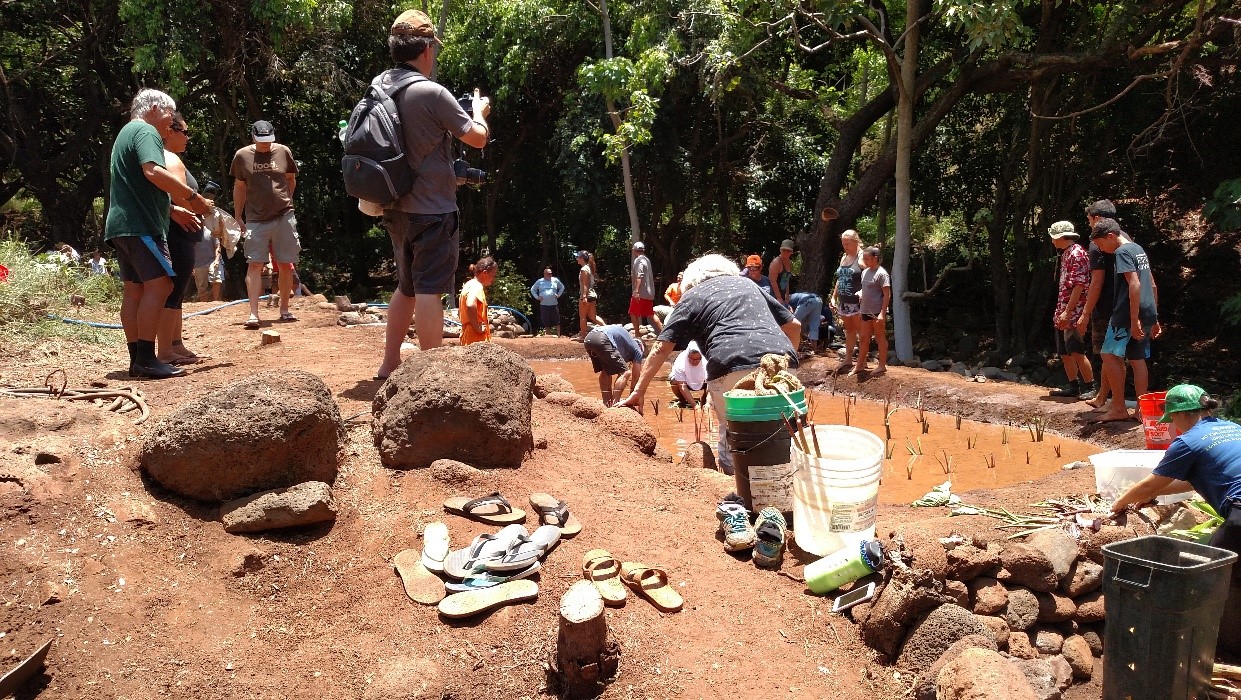On Tuesday August 8, 2023, massive wildfires raged through the historic town of Lahaina in the heart of Maui Komohana. This tragic disaster was over a century in the making.

Lahaina was hailed by early Europeans as the “Venice of the Pacific” because of the well-managed loko ‘ia (fishpond) that surrounded the town center. Photo Credit: https://www.mauimagazine.net/maluulu-o-lele-park-history/
Excessive water diversions by plantations and land developers had turned Lahaina, a once vibrant and productive wetland community known as the “Venice of the Pacific,” into a desert overrun by highly flammable invasive grasses. More than a century of water and land mismanagement set the conditions for the most devastating wildfire in Hawai‘i’s history.
Maui Komohana communities have been organizing for decades to restore their waters. From the south, where Aunty Victoria Kaluna Palafox and her ʻohana maintain lo‘i kalo along Ukumehame Stream on ancestral lands, to the north where the community organization Nā Mamo Aloha ‘Āina o Honokōhau restores Kānaka Maoli traditional lifeways in Honokōhau Valley, communities are returning the beauty of ʻāina and wai to Maui Komohana.
Like many places throughout Hawaiʻi, corporate business ventures, resorts, and expanding urban sprawl have upended kamaʻāina communities and natural ecosystems for generations. In the last century, increasingly larger diversions throttled stream flows needed for kalo farming. Farms failed. New generations moved away. Society as it had once been ceased.
But enough people have sustained traditional culture and values in Hawai’i, so that now the tide of

Thanks to the hardwork of Ka Malua O Kahalawai, the community comes together to re-open lo’i kalo at Kahoma. Photo credit: Bianca Isaki
history is turning. Today, the return to ʻohana-based ʻāina stewardship and return stream flows have reverberated throughout Maui Komohana. In Honokōhau, Nā Mamo Aloha ʻĀina o Honokōhau, is working to reestablish the abundance of the early 20th century, when over over 4,000 lo‘i once covered over 50 acres of this historic valley.
In Kahoma, water protectors Ka Malu o Kahālāwai restored streamflow and celebrated opening loʻi kalo and growing our people’s staple in the valley for the first time in 130 years.
These communities shoulder the kuleana of challenging plantation-era water diversions and tourist resort developments to ensure the pono use of wai. For example, in response to corporate diverters dumping excess water diverted from Honokōhau Stream into fields at Honokōwai, Nā Mamo Aloha ‘Āina o Honokōhau teamed up with Ka Malu o Kahālāwai to bring a legal complaint against the waste. They continue to push for enforcement measures against excessive diversion of Honokōhau Stream.

Community workday hosted by Ka Maul o Kahalawai to re-open ancient lo’i kalo of Kahoma. Photo credit: Bianca Isaki
In Kauaula Valley, kuleana tenants struggle against encroaching water uses by multimillion dollar mansions and transient vacation rentals. ʻOhana in Kauaʻula have been fighting against the dewatering of their historic ʻauwai contrary to Hawai‘i Supreme Court rulings extending back to 1895. They have taken this battle to the Public Utilities Commission to defend their water rights.
With the help of allies across Maui, Hawai‘i nei, and beyond, Maui Komohana communities continue the practices of their ʻohana and kūpuna to work to hoʻi ka nani – to return beauty and to return wai to ‘āina spanning Honokōhau, Honolua, Honokōwai, Kahoma, Kanahā, Kauaula, Launiupoko, Olowalu, and Ukumehame.
